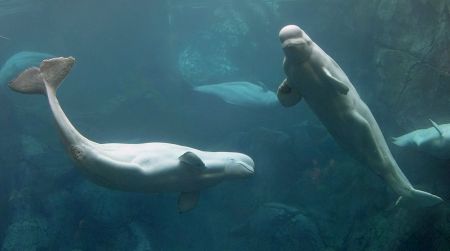It’s a sad day when the list of endangered species gets a little longer, which is exactly what happened late this November. Among the new arrivals to this crestfallen bunch is a species known fondly as the sea canary. You might recognize them by their common name – the beluga whale.
The beluga is a cold loving creature, its body well adapted to the frigid waters of the Arctic Ocean. In fact, the population occupying the Gulf of St Lawrence is the southernmost population of belugas in the entire world, depending heavily on the St Lawrence Estuary for feeding and calving during summer and the Gulf at large during winter. They’re pale white when mature and a pleasant brown or gray when young, growing an average 3.5 metres in length. They are very fond of singing, which is why they’re called the sea canary…but now their playful nickname takes on another meaning.
There used to be upwards of 10,000 beluga’s swimming the Estuary and Gulf. Now it’s believed there are fewer than 1,000, with some estimating fewer than 900. The Committee on the Status of Endangered Wildlife in Canada (COSEWIC) labelled this population as threatened in 2004 but in late November of this year, the belugas were upgraded to endangered.
As with most whale species, the beluga’s population was originally destroyed by commercial whaling, but now they’re the unintended victims of our activities in the St Lawrence Estuary. There’s noise and water pollution from local industry, toxic algal blooms caused by agricultural runoff, destruction of habitat and food sources, death from ship strikes, entanglement in fishing gear, climate change and now high infant mortality. Recent and frightening drops in the St Lawrence beluga population inspired its newly granted endangered status.
A staggering 25 per cent of St Lawrence belugas suffer from cancer, according to a 2002 paper published by Stephane Lair, an associate professor at the college of veterinary medicine at the University of Montreal. It’s believed this results from dangerous levels of water pollution taking place in the Estuary and upriver in the Great Lakes.
We are in serious risk of losing this species, but their recent status change has made quite a “splash,” bringing national attention to the treatment of the St Lawrence Estuary. The Energy East oil pipeline for example, which would carry Alberta’s crude oil to Atlantic Canada for overseas export, was planning to build an oil terminal at Cacouna, Quebec, right on the estuary’s southern shore. Heavily criticised for its potential impacts on the struggling beluga population, this project has been fully halted in response to this species making the endangered list.
Perhaps this is a start, but bold steps need to be taken if this unique population of belugas is to achieve the prosperity it once enjoyed in the St Lawrence Estuary. Pollution and accidental death need to stop…and soon.
Old time miners used to bring canaries with them into coal mines to make sure the air was breathable. If the canary stopped singing, the miner knew it was time to head above ground. In the case of sea canaries - our beautiful beluga whales - we don’t need to wait for them to go quiet. Miner and canary alike can survive this one.
Zack Metcalfe works on the Sierra Club’s Blue Whale Campaign, an initiative to raise public awareness of threats to the Gulf of St Lawrence ecosystem and a call for sustainable management. To learn more about the campaign, visit atlantic.sierraclub.ca/protectthegulf or contact Zack directly at zack.metcalfe@gmail.com



